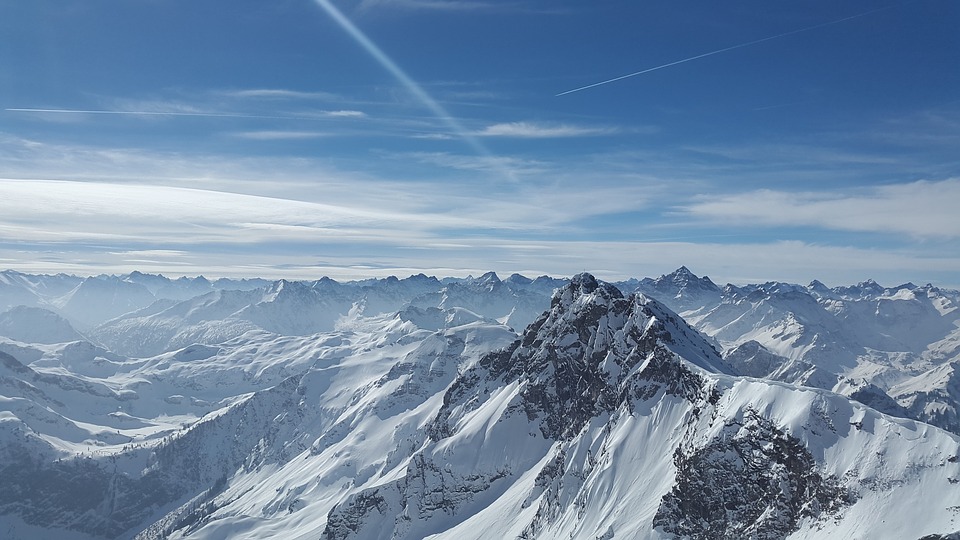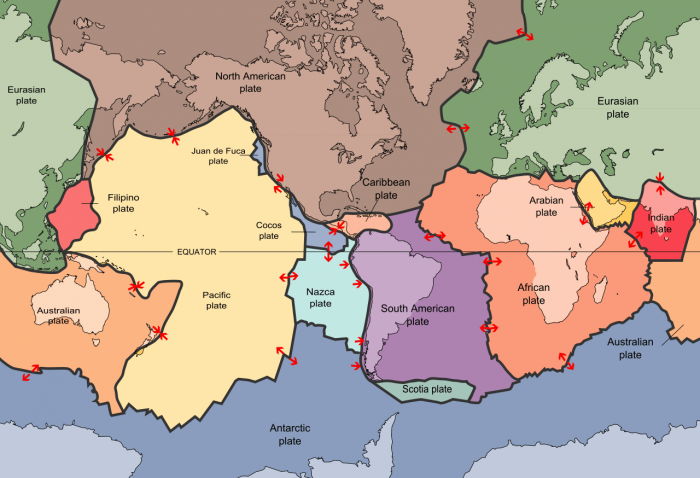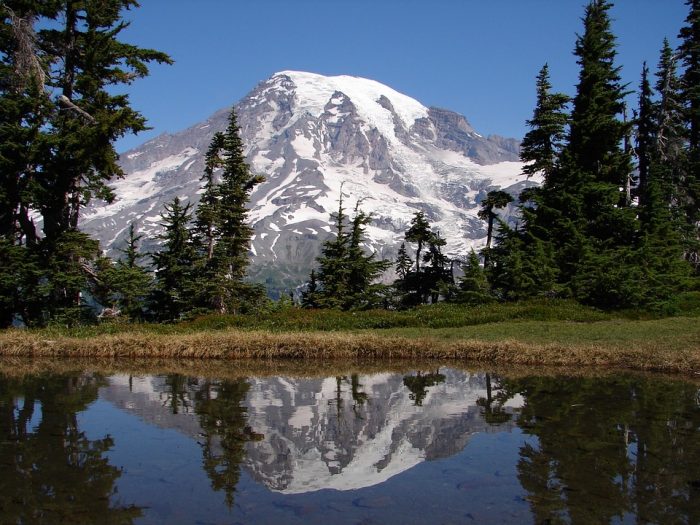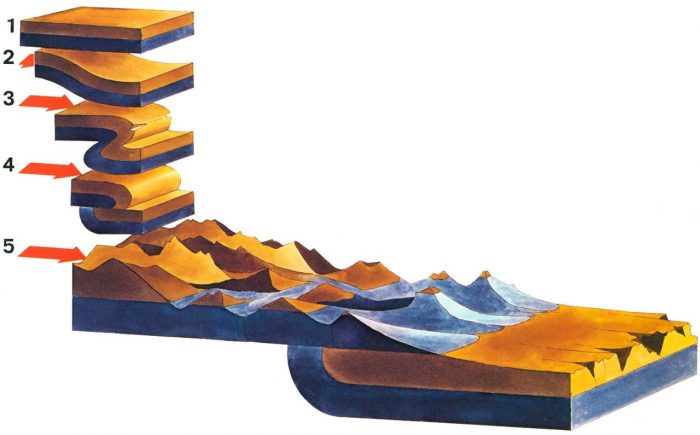
Mountains are some of the most impressive natural structures on earth. Yet how are these massive ridges in the Earth’s crust formed? The process that creates mountains is the large-scale movement of the Earth’s tectonic plates or the earth’s crust.
This movement can be broken up into different processes such as volcanic activity, folding, and faulting. Let’s take a look at how these different processes work together to create mountain ranges.
Understanding Plate Tectonics
Because the formation of mountains is based on the phenomenon of plate tectonics, in order to better understand how mountains form, let’s take a moment to understand the concept of plate tectonics.
The theory of plate tectonics describes how the outer shell of the Earth is divided into many different plates, massive sections of crust that glide over the Earth’s mantle, the region found above the Earth’s core. The Earth’s mantle is softer and more malleable than the Earth’s hard outer crust. The crust of the Earth is part of the lithosphere, which includes the outer portion of the mantle. The lithosphere is approximately 100 km or 60 miles thick, and below it lies the asthenosphere. The malleable properties of the asthenosphere are what enables the lithosphere to glide around on top of it.
The majority of the Earth’s surface lies on nine major continental plates, which are named after the landforms which reside on top of them. These major plates are the Antarctic plate, South American plate, the Indian plate, the Australian plate, the Indo Australian plate, the African plate, the Eurasian plate, the Pacific plate, and the North American plate. The Pacific plate is the largest out of all of the plates, with an area of approximately 103,000,000 square kilometers or 39,760,000 mi.². Outside of the nine major plates, many smaller plates can also be found across the globe. Examples of these smaller plates include the Scotia Plate and the Caribbean Plate.

Photo: By Map:USGSDescription:Scott Nash – File:Tectonic plates.png, Public Domain, https://commons.wikimedia.org/w/index.php?curid=535201
The primary cause of plate tectonics is the convection that occurs in the mantle of the Earth. Hot material rises from the core towards the Earth’s surface, and as this happens the colder material within the mantle sinks. This process of convection causes two different phenomena, the downward sinking of material at subduction zones and the spreading of land at mid-ocean ridges. Midocean ridges are the gaps that occur between tectonic plates. The gaps in the plates allow the magma within the Earth to spill out and reach the surface, which creates new ocean crust and displaces the old crust, pushing the plates apart. Meanwhile, subduction zones are where tectonic plates meet one another. At the subduction zones, one tectonic plate sinks down below the other plate, being absorbed back into the mantle.
There are three different types of plate boundaries. Subduction zones, also referred to as convergent margins, are one of these three boundaries. The other two boundary types are transform margins and divergent margins. Divergent margins are where two plates are spreading apart from one another, which happens at either continental rift zones or seafloor spreading ridges. Meanwhile, transform margins are where plates slide past one another, with a famous example being the San Andreas Fault found in California, where the Pacific plate and the North American plate slip past each other with horizontal motion.
This process of continental movement through plate tectonics was responsible for the creation of a massive supercontinent called Pangaea approximately 300 million years ago. During this time. South America, North America, Europe, and Africa were pushed up against one another, occupying a very close space. As Pangaea broke apart the continents drifted over millions of years to their current positions. The fact that the edges of continents can be placed together like part of a puzzle was one of the first hints that the Earth’s continents moved about and were not stationary.
When tectonic plates collide with each other, they can form mountain ranges. It is thought that the Himalayan Mountains were created approximately 55 million years ago when the continents of Asia and India were forced together by plate tectonics.
Mountain Formation
In general, mountains can be formed in one of three different ways. Faults in the Earth/folds in the Earth, and volcanic activity can all lead to the creation of mountains. These different processes all manifest as a result of plate tectonics, where the movement of matter forces rocks on the surface upwards, resulting in a region of land at a higher altitude than the surrounding land area. Over millions of years, these mountainous regions will be eroded by elements like gravity, rain, ice, and wind. This wears mountainous surfaces down, and the result is that the rocks found on the surface of the mountain are typically younger than the sections of Earth deeper into the mountain.

Mount Rainier is an example of a mountain formed by volcanic activity. Photo: skeeze via Pixabay, CC0
One of the main ways that mountains are created is through volcanic activity. As previously discussed, the surface of the Earth is made up of tectonic plates, seven massive plates on the lithosphere that move relatively slowly, on the order of around zero to 100 mm a year. They can divide (be pulled apart from one another), converge (crash and fold up against one another), or transform (slide by each other). Regions where the crust of one oceanic plate sinks below another plate are referred to as subduction zones. The regions found along plate boundaries allow magma to rise to the surface, and as a result, they create volcanoes. These volcanoes push up from the surface of the Earth, forming mountains as they do so.
Most of the volcanoes on Earth are found in a region referred to as the “Ring of Fire”, a roughly horseshoe-shaped band of volcanic hotspots that encircle the Pacific Ocean. Another region full of volcanoes can be found running from the Mediterranean Sea and across Asia, eventually linking up with the Pacific volcano band near Indonesia. Volcanic mountains tend to be shield volcanoes, such as Mauna Loa in Hawaii, and strata volcanoes or composite cones (rather than cinder cones), such as Mount Fuji or Vesuvius. The defining feature of shield volcanoes is that they slope rather gently, thanks to the low viscosity of their emissions, which are comprised mainly of basalt. The typical example is Mauna Loa, which has a very shallow grade of between 4 to 6°. In contrast, strata volcanoes or composite volcanoes usually result in the mountains with much steeper grades, somewhere between 33° to 40°. The material that makes up these mountains is much more viscous than the material emitted by shield volcanoes, and their eruptions are typically much more violent. Mount Rainier and Mount Hood are examples of these volcanoes.
The second type of mountain is a fold mountain. These mountains are formed at subduction points when the tectonic plates collide with one another. These regions fold upwards thanks to the powerful force generated by the collision of the two plates together. This is especially likely to occur when there is a mechanically weak layer found in the region of the collision, such as a salt layer. Mountain regions formed in this fashion tend to be longer than they are wide. Examples of these regions are the Jura Mountains and the Appalachian mountain range. The collision of tectonic plates can also create mountainous foothills in regions adjacent to it, referred to as a fold and thrust belt. These regions are created as the deformation that occurs as the colliding propagates outwards. The Alps are an example of a fold and thrust belt.

How fold mountains are created. Photo: By Greg Beaumont, National Park Service – National Park Service – used in the online edition of the book “MANY-STORIED MOUNTAINS – The Life of Glacier National Park” by Greg Beaumont, first published 1978 and online at , Public Domain, https://commons.wikimedia.org/w/index.php?curid=6187197
Block mountains are mountain regions that have a more contiguous outline than fold mountain regions. The profile of the mountain range resembles a block or slab. This mountain range occurs when a fault block, a slab of earth surrounding a fault, is spread apart thanks to the tensional forces that occur as the plates move. If tensional forces are sufficient enough to split apart a plate, a central block will drop downwards in relation to the adjacent earth blocks. If this happens multiple times within a region, the landscape may have a trough followed by a higher block followed by another trough, creating a block mountain range. An example of such a phenomenon occurring is the Sierra Nevada mountains. Delamination in the Sierra Nevada range created a block of Earth that is roughly 80 km wide and 650 km long. Another example of block mountains is the Rila mountain range found in Bulgaria.
While the above mechanisms are the primary way that mountains are created, another type of mountain, referred to as residual mountains, can be created as a result of erosion. If there is an elevated land region and parts of it are worn away thanks to erosion, leaving a steep gradient behind, this would be a residual mountain. It is as if the mountain has been carved out of a larger elevated landmass by erosion. Examples of such mountains include the Eastern Rhodopes (Bulgaria), the Scottish Highlands (Scotland) and Snowdonia (in Wales).
It isn’t entirely clear what the mechanisms responsible for the creation of elevated passive continental ranges are. Regions like Australia’s Great Dividing Range, the Brazilian Highlands, and the Scandinavian Mountains could have been made by stress to the Earth’s lithosphere in points relatively far from them, though the mechanisms that created them are probably the same as uplift mountains.









